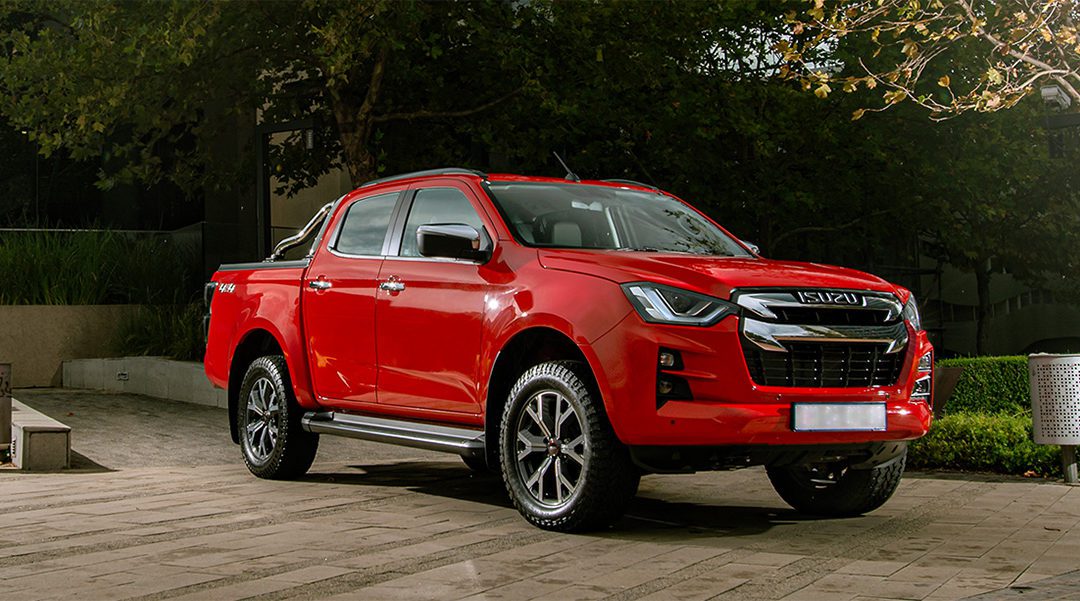In March 2022, the first 7th generation Isuzu D-Max bakkie engineered in South Africa rolled off the production line. A momentous occasion for the Isuzu Motors South Africa (IMSAf) Struandale Plant in Gqeberha and a boost to the economy and communities in the Nelson Mandela Bay metro.
Punted as Isuzu’s “boldest bakkie yet”, the latest D-Max offers 24 new models in three body styles to appeal to everybody’s unique requirements. Before its launch, there were very high expectations for the latest Isuzu D-Max, and hopes were pinned on the key features that the engineers focussed on to suit local market conditions.
Let’s take a look.
On the inside
One of the previous criticisms of the Isuzu D-Max was its view as a utilitarian vehicle and not a leisure vehicle. They’re now describing themselves as a business or leisure vehicle, ideal for off-roading trips, road-tripping family holidays, and driving around the concrete jungle.
The interior has been refined and, depending on the model, offers power or manually adjustable leather or cloth-covered seats with lumbar support. Shoulder room in the back of the double cab has been extended by 20 mm, and the legroom has also been improved. There’s dual-zone air conditioning, pollen filters, electric windows, a hands-free car kit, USB charging ports and ports for music.
Your smartphone can integrate with the infotainment system thanks the in-vehicle Wi-Fi, Apple CarPlay® and Android Auto. Unfortunately, Android Auto is currently not supported in Zimbabwe, but hopefully they’ll update that at some point in the near future. With a seven or nine-inch HD WXGA display, you will have a crystal-clear view of the system’s controls for regular safety checks or quick navigation checks to ensure you don’t get lost. There is also a full centre floor console with a soft padded lid to protect your elbows on those bumpy roads.
There are a host of safety features, with the double cab receiving most of them, including an ISOFIX child seat attachment to cater to all the new families out there. But standard in all models is ABS brakes, brake assist system, electronic stability control with traction control, hill start assist and hill descent control, and trailer-sway control. The Isuzu Intelligence Driver Assistance System (IDAS) will keep track of your surrounding environment and provide intuitive active alerts in the event of danger.
On the outside
From the ground up, the Isuzu D-Max has 17 or 18-inch tyres and either steel or alloy wheels. There are also tyre pressure monitoring sensors across the LSE and V-CROSS models. A new wider and tougher chassis has been included and the front and rear suspension has been revised with a longer wheelbase across the entire range to maximise loading capacity and space. Isuzu have also modified the body and frame to increase strength.
The grille is more prominent and has the sexy signature dragon eye motif of the front lights. Rain-sensing windscreen wipers, which come standard on the LSE and V-CROSS models, are automatically activated when it rains, and the wiping frequency even adjusts as it rains harder.
Halogen or LED daytime running lights are standard from LS trim-level upwards to increase safety and improve visibility. The V-CROSS also auto-dims the high beams when oncoming lights are detected.
The loadbox was a key project that the engineers undertook and has resulted in significantly thicker steel in strategic areas such as the inner panels, front panel and tailgate. The loadbox has gained an extra 30 mm in height and on the sides. It now measures in at a length of 1 495 mm, a width of 1 530 mm, and a depth of 490 mm. There are also four tiedown brackets for load restraint.
Offroading has become a lot more fun as a high-ride suspension comes standard across all models. Water crossings will be a breeze with a 212 – 227 mm ground clearance and a wading depth of 800 mm. And you’ll be able to tackle those rocky hills as some models come with an electronic, standard rear differential lock.
Under the hood
There is a choice of a 1.9 or 3.0 litre turbo-charged diesel engine with 6-speed manual or 6-speed automatic transmissions and a 4X2 or 4X4 drive configuration.
A 76-litre fuel tank comes standard and will get you between 7.3 – 8.2 litres per 100 km, depending on the model. A smart, ‘gradelogic’ transmission has been installed to prevent over-revving and thus unnecessary fuel burn.
We can’t wait for you to experience the new Isuzu D-Max 7th Generation. Feel free to chat with the guys at Autoworld to learn more about this bold bakkie or to book a test drive.
